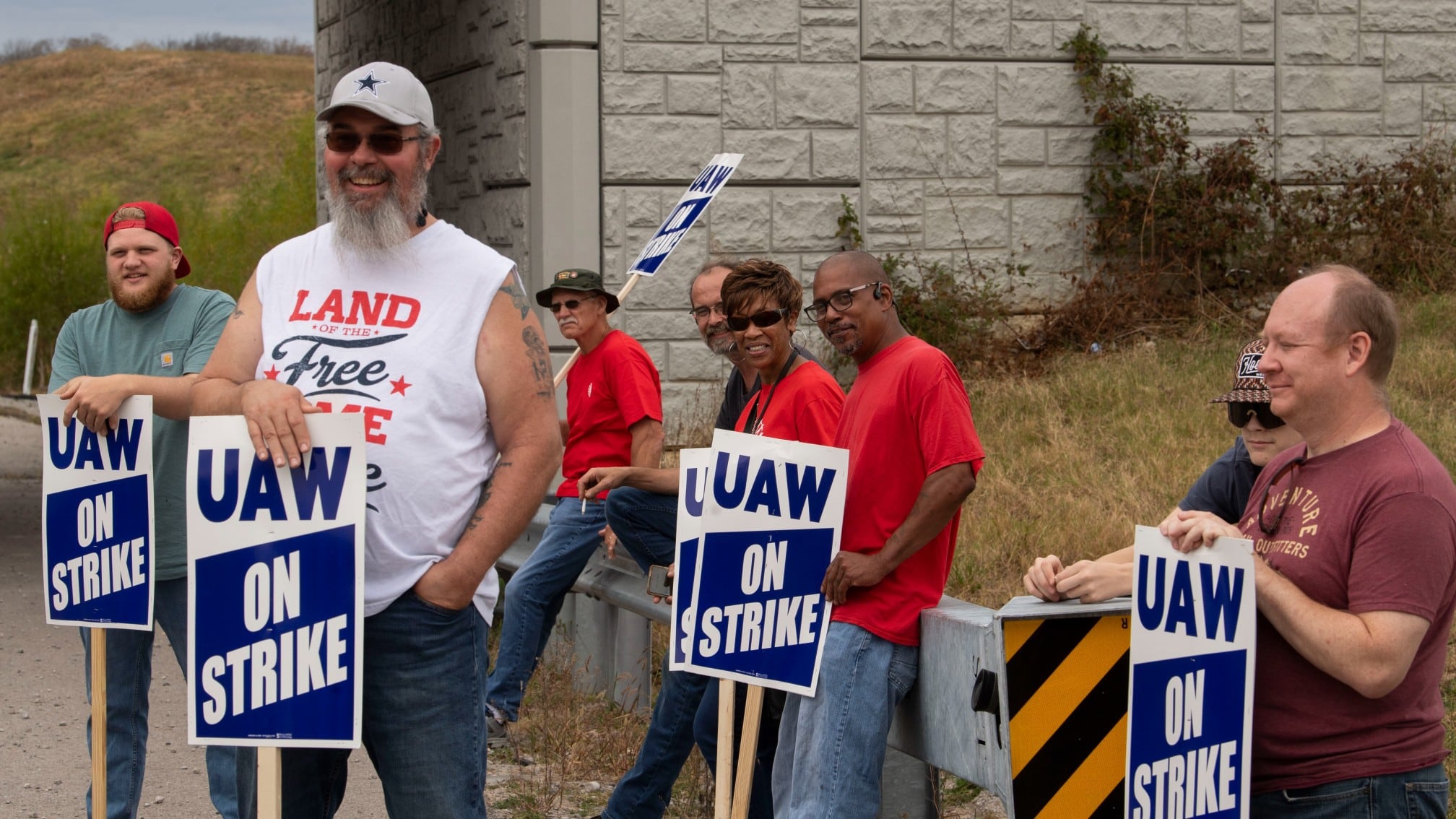By Tom Krisher
Facing the loss of another $200 million this week to a lengthy strike, General Motors CEO Mary Barra wrapped up her weekend by going to the United Auto Workers' Detroit headquarters intent on getting a new contract.
Joined by manufacturing chief Gerald Johnson at the meeting that started late Sunday, they were able to close a deal with UAW President Shawn Fain and other bargainers early Monday that should end a contentious six-week work stoppage, three people briefed on the matter said Monday.
The tentative deal, which came on Fain's 55th birthday, capped a furious few days of agreements that still need to be ratified by 146,000 UAW members at GM, Ford and Jeep-maker Stellantis. Ford agreed to a new contract last week and was followed by Stellantis on Saturday, which raised the pressure on GM to settle for essentially the same terms.
All agreed to contracts that would last four years and eight months, raise general wages 25% for top assembly plant workers and add cost of living adjustments that would bring their pay increases to over 30% by the time the contracts end on April 30, 2028, said the people, who asked not to be identified because they weren't authorized to talk publicly about the deal. Workers would get an immediate 11% pay raise upon ratification.
The deal should make Fain's birthday a happy one. Most industry analysts say contracts with the Detroit Three are victories for the UAW, which had sought big gains to make up for concessions it made to help the companies get through the Great Recession of late-2007 to 2009.
But during the talks, the companies said they were reluctant to agree to the union's terms, fearing they would force them to raise vehicle prices higher than competitors with nonunion factories in the U.S., including Toyota and Tesla.
For GM, which was losing millions of dollars each week the strike lasted, the impetus was clear: Reach a deal so it could open an SUV factory in Spring Hill, Tennessee, on time Monday morning, and get a highly profitable truck-based SUV plant in Arlington, Tennessee, back online as soon as possible.
It wasn't immediately clear whether the Tennessee plant did open on time, but about 18,000 striking workers at GM assembly plants and parts warehouses across the nation remained on the picket lines Monday morning awaiting official word from union officials that the strike would end.
Mike Huerta, president of UAW Local 602 in Lansing, Michigan, was hesitant to celebrate the deal before seeing more information, saying that “the devil’s in the details.”
“Our bargainers did their job. They’re going to present us with something and then we get to tell them it was good enough or it wasn’t,” said Huerta.
With workers huddled around a fire behind him, Huerta said that it’s been a tough few nights on the picket lines with dropping temperatures and rain, but that spirits have remained high.
“We were ready to continue if we needed to,” Huerta said. “And if we do turn it down, we’ll be ready to go back again.”
Shammira Marshall, a forklift driver at GM's parts warehouse in Van Buren Township, Michigan, west of Detroit, said the holidays will be a bit nicer this year thanks to the tentative deal.
“Christmas, Thanksgiving, the New Year — that’ll help,” she said of her expected raise.
This marked Marshall’s second strike against GM, having walked picket lines in 2019. As word came down of a deal, she and other UAW members worked to disassemble a tent that strikers had used.
“This time it wasn’t bad, because I knew what to expect," she said.
GM was the last company to reach a deal, and it came after nearly 4,000 union workers walked out of GM’s largest North American plant, in Spring Hill, Tennessee, by surprise on Saturday night.
President Joe Biden was asked about the deal Monday, as he boarded Air Force One back to the White House. He gave a thumbs-up and said: “I think it’s great.”
Also Monday, 8,200 Stellantis workers in Canada represented by a different union, Unifor, briefly went on strike before reaching a deal that comes with base hourly wage increases of nearly 20% for production workers. General Motors and Ford workers in Canada have already voted to ratify a three-year contract agreement with the company.
Spring Hill, the plant where workers hit picket lines Saturday, produces the engines for vehicles assembled at nine plants as far afield as Mexico, including Silverado and Sierra pickups. It's a big money maker for GM that could have potentially amplified the company's financial pain after workers walked off the job last week in Arlington, Texas, where full-size SUVs including the Tahoe and Suburban are produced. Spring Hill also produces the electric Cadillac Lyriq, GMC Acadia and Cadillac crossover SUVs.
Presidents of the Ford union locals voted unanimously in Detroit on Sunday to endorse that tentative contract after UAW President Shawn Fain explained its details, the union tweeted.
As he explained the particulars to the full membership in a later livestream, Fain, along with Chuck Browning, the UAW vice president, said the deal represents a “historical inflection point” for reviving union power in an America where "we were being left behind by an economy that only works for the billionaire class.”
“UAW members at Ford will receive more in straight general wage increases over the next 4 1/2 years than we have over the last 22 years combined,” Browning said.
Fain called the deal “a turning point in the class war that has been raging in this country for the past 40 years.”
The agreements revive cost-of-living adjustments that the UAW agreed to suspend in 2009 during the Great Recession.
At Stellantis, workers get cost-of-living pay that would bring raises to a compounded 33%, with top assembly plant workers making more than $42 per hour. Top-scale workers there now make around $31 per hour.
Starting wages for new Stellantis hires will rise 67% including cost-of-living adjustments to over $30 per hour. Temporary workers will get raises of more than 165%, while workers at parts centers will get an immediate 76% increase if the contract is ratified.
Like the Ford agreement, it will take just three years for new workers to get to the top of the assembly pay scale, the union said. Similarly, the union won the right to strike over plant closures.
The UAW began targeted strikes against all three automakers on Sept. 15 after its contracts with the companies expired. At the peak, about 46,000 UAW workers were on strike — about one-third of the union’s 146,000 members at all three companies.
____
AP Writers Frank Bajak in Boston, Michelle Chapman in New York, Joey Cappelletti in Lansing, Michigan, and Mike Householder in Van Buren Township, Michigan, contributed.









